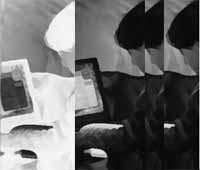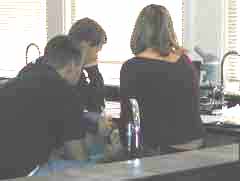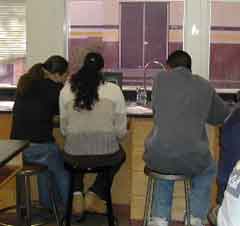|
|
| Vol 13|No 4|December|2003 | |
|
Please feel free to e-mail this article to a friend, a principal, a parent, a colleague, a teacher librarian, a college professor, a poet, a magician, a vendor, an artist, a juggler, a student, a news reporter or anyone you think might enjoy it. Other transmissions and duplications not permitted. (See copyright statement below).
This is a strange book - a disturbing book freighted Partial Truths? The Flickering Mind is divided roughly into three sections, but a fourth (and crucial) section is missing. Oppeneheimer starts with tales of disappointment and folly, crisscrossing the nation to look at schools that are under-resourced or technologically fervent. He gathers mostly examples that illustrate his thesis. In his second section, he devotes many pages to the criticism of questionable products like Accelerated Reader and the hard sell of various vendors. The book closes with a section idolizing the Waldorf schools and one small experimental school in New York. Oppenheimer idolizes or demonizes. Few humans or schools occupy the vast middle. The view is black and white. We have good guys and bad guys, sages and fools. We have high tech schools and stodgy schools. The missing section? The book should have and could have told the stories of teachers who have made smart use of new technologies and kept them in their proper place. While Oppenheimer maintains that such teachers are rare, merely accidental and mostly just anomalies, perhaps he was so endeared to his thesis and his preconceptions that he flew over such teachers and schools as he sought confirmation of his 1997 claims in "The Computer Delusion," his article in Atlantic Monthly that first advanced his thesis. An online version is available at http://www.theatlantic.com/issues/97jul/computer.htm While many sections of his book deserve debunking, this review will focus on his portrayal of schools and technologies in Napa, California.
Perhaps Oppenheimer picked two bad days to visit back in 1998/99. Maybe the school has changed. Maybe he saw what he hoped to see. I know that the school I visited in November of 2003 did not resemble the school he criticizes in his book. Sour Grapes in Napa When I read Oppenheimer's chapter on the New Technology High School in Napa, I found myself wondering if he had done the school justice. My suspicion was prompted, in part, by his characterization of the other high schools in Napa as "stodgy." When providing a workshop for Napa High, I had seen nothing stodgy. I was also troubled by his harsh words and characterizations, especially since he held individuals up to public ridicule. Most educational researchers hold back the names of individuals, especially when writing critically for national publication. While Oppenheimer claims his naming of names enhances his credibility, I think it undermines it.
When I visited Napa, I found much that conflicted with Oppenheimer's portrayal. During my visits to both high schools I never saw a student playing any games, for example, in contrast with the statement above. And I am quite skilled at noting this kind of adolescent behavior from a distance before they can ALT-Tab as they did when Oppenheimer visited. The carnival atmosphere he mentions was no where to be found. His theory of technological determinism stumbled and collapsed on both days of my visit.
As one who visits high schools across the world, I found nothing stodgy or especially traditional about Napa High School. If anything, it hums with energy and tilts dramatically towards the progressively hip style of educating one would expect from a good California high school. I really wonder how Oppenheimer surmised its allegedly stodgy nature or how he could justify affixing the label "education at its most traditional" to a school that is far from that stodgy condition. A presumptive strike? Knowing without checking? Almost every time I visited classrooms in Napa where someone thought good learning was going on, the actual exercises were meaningful, well managed, rigorous and quite impressive. This was the case in both schools, the New Technology High School as well as the more conventional school Oppenheimer called "stodgy" but evidently failed to visit. I encountered no boasting. As I walked through one courtyard at Napa High School, a math teacher grouped his students outside where they were busy timing sprints around the sidewalk - data to be entered in graphs back in the classroom. Hardly a stodgy approach to math. I found myself wondering if this journalist had "flown over" more than one high school.
As is quite typical of Oppenheimer in this book, he is comfortable painting entire groups with broad (and insulting) brush strokes.
Evidently, Oppenheimer did not visit either of the two conventional high schools in Napa. He targeted, instead, the special school, noted what seemed to match his thesis and limited his search. I visited two schools - the New Technology High School and Napa High - and saw nothing to confirm Oppenheimer's harsh judgments or his thesis in either school.
Looking for Surprise and Counterpoint Those with a thesis have a responsibility to seek evidence that might force them to reconsider, revise and even reverse that thesis based on their research. In his book, Oppenheimer reports almost no effective uses of new technologies and dismisses those few as accidental exceptions, peculiarities and accidents. Most of his stories focus on failures and embarrassments Learning to Debate at the New Technology High School In one class I visited at the New Technology High School, students were working in teams to prepare for an upcoming debate. These teams were seated comfortably around and on top of tables. They were chatting with good concentration as one team member took notes on lined composition paper. They were outlining arguments and identifying research that would need to be conducted.
There were no computers at these tables and the students seemed happy with paper. The teacher met with one team while the other teams worked without any need for teacher strong arm tactics. There was no chaos, no off task behavior and no inappropriate socializing.
Issues of Fact (or was that Conjecture?) There were quite a few times when I wondered at the veracity of Oppenheimer's claims.
The Fall 2003 community college enrollments present a somewhat different picture:
Oppenheimer faults the school for what he sees as its narrow focus and compares it unfavorably to comprehensive high school programs nearby, but he seems to miss the point that this is a school for students eager to make an early choice. It would be just as silly to attack a magnet school for the performing arts because it had a narrow focus.
The language used in this passage begs further investigation, as administrators constantly boast and students are playing games in virtually every heavily computerized classroom. Oppenheimer asserts the truth on this score but never offers credible data. He cites numerous accounts from students. At the end of November, 2003, an informal survey of nine New Tech students (out of 25+) working late several afternoons on computers in the research center turned up the following data:
This data is only a glimpse of student use, but it calls into question Oppenheimer's claim that after school use is merely a way of compensating for game-playing. To make his assertion stick, we would expect to see more desperation and last minute scurrying. There were not even that many students staying late. More Cheap Shots Oppenheimer is very critical of the New Technology High School's focus on project-based learning and contructivism as he equates these approaches with educational surrender. He misunderstands, misconstrues and misrepresents this teaching method (project-based learning) and this school of learning psychology (constructivism) by caricaturing "the Guide on the Side" as a strategy that means good teachers stop teaching. He lumps the strategy and the school of psychology together and heaps scorn on both.
This section of his book is filled with nonsense and distortion. He suggests, for example, that this approach to teaching had its beginnings at Summerhill - a thoroughly discredited educational experiment with excessive freedom and license. Serious proponents of constructivism expect teachers to structure activities well so that students can keep moving forward without frequent teacher interventions. The teacher is not a guide banished to the sidelines. The teacher moves frequently and performs many of the following tasks:
Somehow, Oppenheimer failed to research constructivism with any thoroughness. His notes for this chapter ignore the entire research base for this approach to teaching. There are no references cited at all, yet he acts as if he were familiar with the literature and manages to discredit the entire movement dismissively and securely. He muddles Summerhill with John Dewey and more recent thinkers as if no one has learned anything in the past hundred years. It is unfortunate and troubling that he did not spend a few minutes reading and reporting the literature on constructivism, which is all it would have taken to clear up the muddle he had created. A responsible and thorough investigation of constructivist thinking and thinkers would have explored the writings of Jerome Bruner, for example, who clearly articulated a case for carefully structured learning in contrast to Oppenheimer's offhanded caricature. For a good summary of Bruner's basic approach, take a look at http://www.artsined.com/teachingarts/Pedag/Constructivist.html, a resource provided by the Arts in Education Program at the University of Western New York.
For a comprehensive listing of dozens of other important thinkers, take at look at http://carbon.cudenver.edu/~mryder/itc_data/constructivism.html, a bibliography provided from Colorado University at Denver. While it is true that Oppenheimer is a journalist, not an educator, and can not be expected to research complex psychological issues as if he were trained to do so, even a layperson should be able to do more than a "fly over" when it comes to an entire educational approach such as constructivism. Other Issues It would take an entire book to outline the many problems embedded in Oppenheimer's "fly over" of educational technology. There are problems of fact, distortion and inaccuracy. Added to these are tendencies to view life in simplistic, unreal terms - black-and-white or clusters. At one point in his book he is very critical of computer simulations for their distortion and oversimplification of reality, but later he idolizes Tom Snyder as if he were unaware that much of Tom's product line employed simulation as a prime strategy. In many ways his own book is a simulation - an over-simplified model of reality constructed with a narrow focus and a strong ideological bent. Those of us who see some value in smart use of technology are lumped together with Bill Bennett and the promoters of Accelerated Reader. He seems unaware of varying segments, camps, schools of thought or conflicting approaches. We are all simply joined together in one derisive phrase - "education's technology enthusiasts." This misrepresents reality and hides some very important information. Some approaches to new technologies are more fruitful than others, but you would hardly know that from reading Oppenheimer. Throughout the book, Oppenheimer peppers his own thoughts, judgments and strongly held points of view with sound bites from other thinkers, many of which are quoted without context but almost always echo or applaud Oppenheimer's own point of view. He idolizes MIT's Judah Schwartz and quotes him frequently.
He lines up expert sound bites as if the briefly stated opinions of others were sufficient to prove points, many of which are quite questionable. He criticizes (or has others criticize) others for this very tactic:
He is harshly critical of others who distort the truth but seemingly unaware of the irony of his accusations:
Frozen in Time Back in 1998-99 when Oppenheimer visited New Technology High School, the world was flirting with the dotcom revolution and the speculative fervor of new technologies that promised to turn life upside down and inside out. Many schools with the courage to explore these potentials found themselves disillusioned and swiftly moved to shed the ineffectual and inconsequential. Some remain captivated and captive. Oppenheimer fails to mention this learning process or to credit schools and pioneers for lessons learned. While good schools, especially experimental schools, are always in motion trying to figure out the best ways to promote student learning, Oppenheimer was satisfied with a gallery filled with still life after still life - images and sketches that recapture his 1997 original view of educational technologies. He is doing Technology 1997 Déjà Vu.This does such schools and the teachers he described an injustice. The book offers little in the way of illumination. Its title suffices as a warning to those easily seduced by new technologies. Embrace new technologies uncritically, fail to fund professional development and ye shall reap flickering minds! |
||||||||||||||||||||||||||||||||||||||||||||||||||||||||||||||||||||||||||||||||||||||||
|
Back to December Cover
Credits: The photographs were shot by Jamie McKenzie . Copyright Policy: Materials published in From Now On may be duplicated in hard copy format if unchanged in format and content for educational, nonprofit school district and university use only and may also be sent from person to person by email. This copyright statement must be included. All other uses, transmissions and duplications are prohibited unless permission is granted expressly. Showing these pages remotely through frames is not permitted. FNO is applying for formal copyright registration for articles. Unauthorized abridgements are illegal.
|
 From Now On
From Now On








